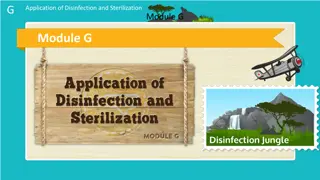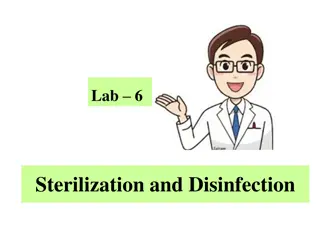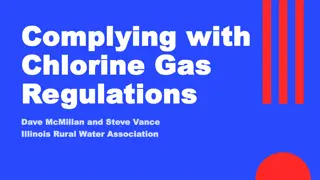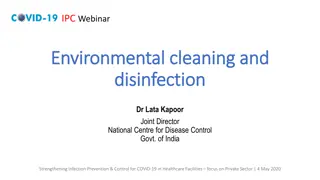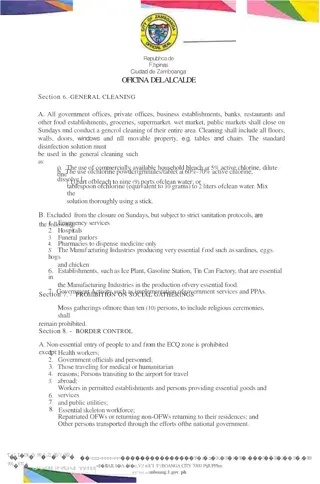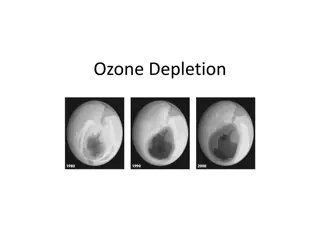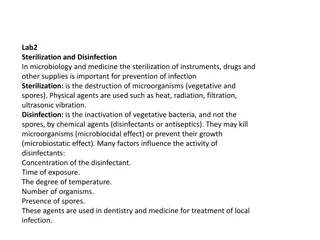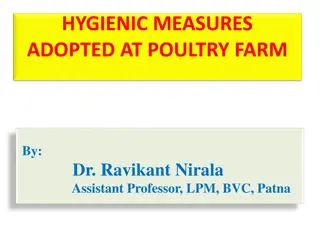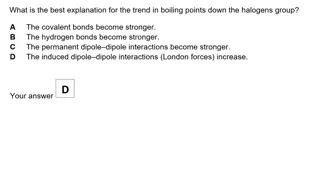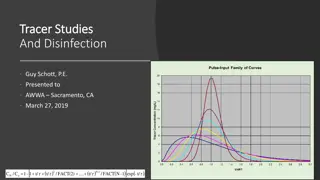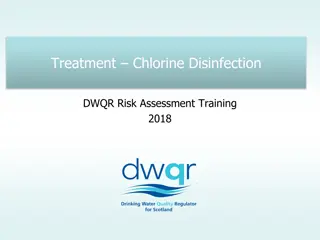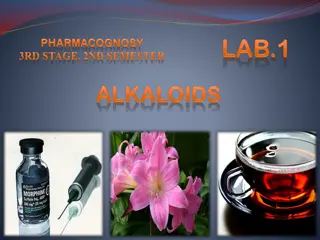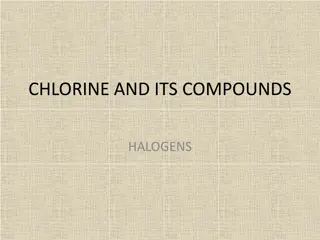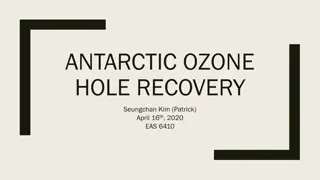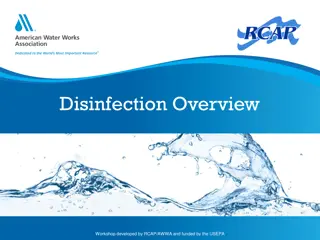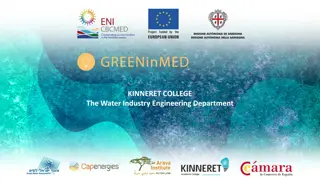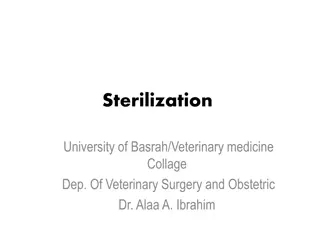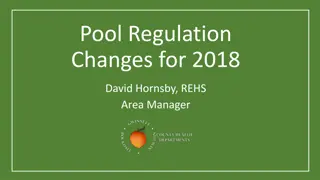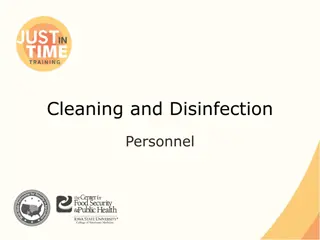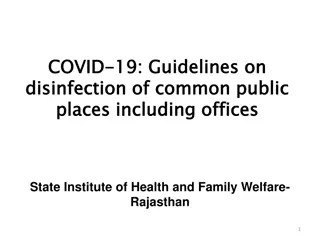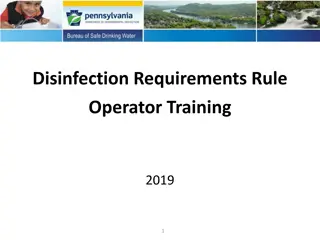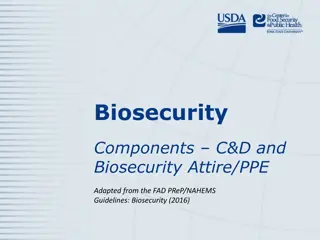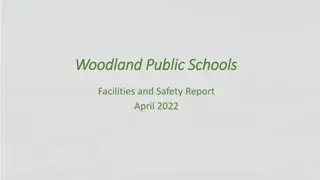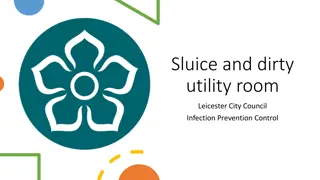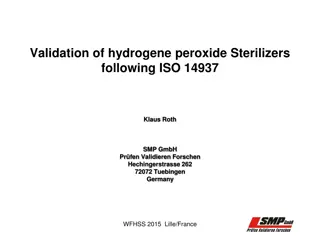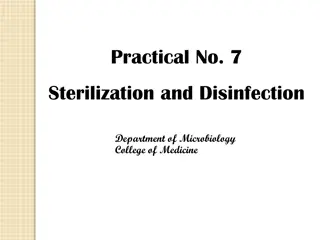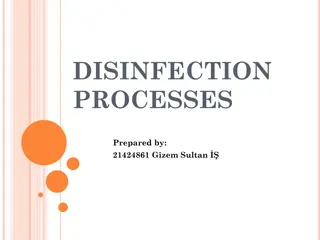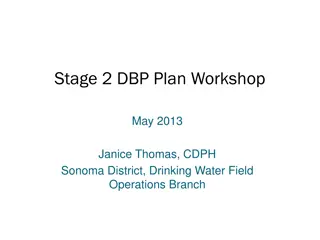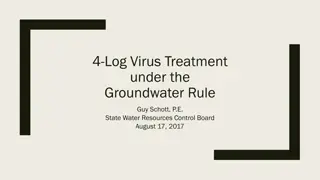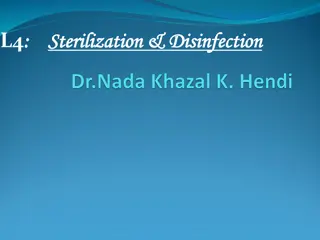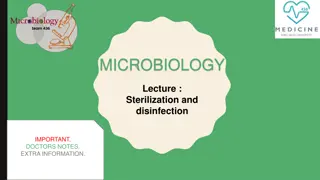Best Practices for Disinfection and Sterilization in Healthcare Settings
Explore the application of disinfection and sterilization in various healthcare settings like outpatient facilities, physical therapy, hydrotherapy, gym areas, and portable equipment. Learn about the importance of following strict infection control practices, cleaning protocols, and disinfectant rec
1 views • 27 slides
Water Purification Methods and Techniques Explained
Explore the purification of water on both large and small scales, including storage, filtration, and disinfection processes. Learn about different methods such as boiling, chemical disinfection, and filtration for household water purification. Discover the importance of treatment based on the nature
4 views • 66 slides
Understanding Sterilization and Disinfection Methods in Laboratory Settings
Sterilization involves killing all microorganisms while disinfection targets pathogenic ones. Various methods like heat, filtration, radiation, and chemicals are used for effective sterilization. Physical sterilization through heat includes dry heat, direct flaming, hot air ovens, and incineration.
4 views • 21 slides
Complying with Chlorine Gas Regulations
Explore the compliance and reporting requirements related to handling chlorine gas in water treatment facilities. Learn about the regulations set by organizations like IEMA, EPA, and OSHA, emphasizing safety measures, reporting thresholds, and emergency planning in response to hazardous substances.
0 views • 32 slides
Best Practices for Environmental Cleaning and Disinfection in Healthcare Settings
Effective environmental cleaning and disinfection are crucial in reducing healthcare-associated infections, especially in the context of COVID-19. This webinar by Dr. Lata Kapoor emphasizes the importance of cleaning high-touch surfaces and implementing established cleaning strategies to remove biob
1 views • 18 slides
Guidelines for General Cleaning and Prohibitions in Zamboanga City
The document outlines regulations for general cleaning on Sundays in Zamboanga City, with specific disinfection protocols using bleach and chlorine. It also prohibits social gatherings and non-essential entry of people to and from the Enhanced Community Quarantine zone, except for essential workers
1 views • 13 slides
Understanding Ozone Depletion: Causes and Impact
The ozone layer, found in the stratosphere at 15 to 40 km altitude, plays a crucial role in absorbing harmful ultraviolet radiation. However, due to the use of Chlorofluorocarbons (CFCs), the ozone layer has been depleted, leading to the formation of the ozone hole. This depletion is caused by chemi
0 views • 27 slides
Sterilization and Disinfection in Microbiology and Medicine: Importance and Methods
Sterilization and disinfection are crucial in preventing infections in microbiology and medicine. Sterilization involves the destruction of microorganisms, while disinfection targets vegetative bacteria using chemical agents. Factors affecting disinfectant activity include concentration, time of exp
1 views • 7 slides
Hygienic Measures for Poultry Farm Management
Poultry waste management, farm hygiene, sanitation, and environmental issues are critical for maintaining a healthy poultry farm. Disinfection, while important, is not a substitute for cleanliness. Effective disinfectants should have good germicidal activity, be non-toxic to humans and birds, work o
0 views • 18 slides
Chemical Reactions and Separation Techniques in Chemistry
This presentation covers various chemical reactions and separation techniques in chemistry, including electron configuration, precipitation reactions, chlorine reactions with sodium hydroxide, and apparatus used to separate immiscible liquid layers. Explore topics such as electron configurations of
0 views • 28 slides
Understanding Tracer Studies and Disinfection in Water Treatment
Tracer studies play a crucial role in determining hydraulic efficiencies and disinfectant exposure times in water treatment processes. This presentation by Guy Schott covers the purpose of tracer studies, water age distribution, disinfection exposure time, CT disinfection, log inactivation, and more
0 views • 34 slides
Essential Guidelines for Chlorine Disinfection in Water Treatment
Learn about the usage and key points to watch for when implementing chlorine disinfection in water treatment processes. Understand the effectiveness, dosing methods, safety considerations, and monitoring protocols to ensure successful water disinfection. Proper handling of hypochlorite solution, mon
1 views • 7 slides
Overview of Alkaloids: Classification, Sources, and Characteristics
Alkaloids are organic nitrogenous compounds found in plants with physiological activity. They may also contain elements like oxygen, sulfur, chlorine, and phosphorus. Alkaloids can be sourced from plants, animals, bacteria, fungi, or industrial synthesis. Their names can be derived from plant names,
0 views • 19 slides
Chlorine and Halogens: Properties, Reactions, and Industrial Uses
Halogens, including chlorine, are in group 7 of the periodic table and have 7 electrons in their outer shell. They easily form negative ions by gaining an electron. Chlorine is symbolized as Cl and has two isotopes, 37Cl and 35Cl, with an electronic arrangement of 2:8:7. It can be prepared in the la
4 views • 31 slides
Antarctic Ozone Hole Recovery and Future Challenges
Depletion of the stratospheric ozone layer in Antarctica due to chlorine emissions led to the formation of the ozone hole. Since the phasing out of Ozone-Depleting Substances (ODSs) under the Montreal Protocol, there has been a reduction in anthropogenic ODSs in the troposphere. Observations and che
0 views • 12 slides
Comprehensive Overview of Water Disinfection and Chlorination Basics
This workshop explores the importance and various methods of water disinfection, focusing on chlorination basics, chloramines, disinfection types, and the impacts of pH on chlorine disinfection. Learn about the necessity of disinfection in water systems, different disinfectants used, and the need fo
0 views • 37 slides
Kinneret College Water Industry Engineering Department Overview
Kinneret College, established in 1965, offers B.A. and B.Sc. degrees through its School of Engineering, with a focus on Water Industry Engineering. The department, led by Prof. Ram Shpiner, provides a balanced mix of practical and theoretical studies to prepare engineers for the evolving water indus
0 views • 9 slides
Guidelines on Sterilization, Disinfection, and Types of Disinfectants in Veterinary Medicine
Sterilization is the process of eliminating all microorganisms from an object, while disinfection reduces the number of pathogenic microorganisms on surfaces. Various types of disinfectants exist, including high-level, intermediate-level, and low-level options. Different equipment items in veterinar
0 views • 18 slides
Essential Laundry Tips: Washing Instructions, Clothing Preparation & Bleach Safety
Understanding the importance of reading garment labels before laundering, proper clothing preparation tips, knowing which types of clothing to wash in hot, warm, or cold water, precautions for using chlorine bleach, benefits of powdered oxygen bleach, and why chlorine and ammonia should never be mix
0 views • 16 slides
High-Quality Disinfection Products to Protect Your Business
Step into a safer, cleaner world with Chemical Essentials\u2019 high-quality disinfection products. \n\nOffering unmatched microbial kill and unrivalled safety, it's the ideal choice for any setting, from laboratories to home kitchens. \n\nIts unique
2 views • 3 slides
Buckingham Park Water District Tracer Study by Guy Schott: Detailed Analysis
Detailed analysis and findings from a tracer study conducted on 2/10/16 at Buckingham Park Water District by Guy Schott. The study includes information on the 200K Clearwell, outlet configurations, baffle heights, nozzle velocities, chlorine residual levels, and more. Insights on flow rates, dosage,
0 views • 13 slides
Pool Regulation Changes for 2018 - Important Updates for Pool Maintenance
In 2018, David Hornsby, REHS Area Manager, introduced significant changes in pool regulation. These changes include updated minimum disinfectant levels, specific requirements for different pool types such as spas, interactive water play pools, activity pools, wading pools, and more. Additionally, ma
0 views • 31 slides
Biosecurity Cleaning and Disinfection Procedures
This guide outlines biosecurity cleaning and disinfection procedures, including small-scale C&D stations, personal protective equipment protocols, personnel decontamination steps, emergency medical situation guidelines, and equipment sanitation measures. It emphasizes the importance of thorough clea
0 views • 21 slides
Cleaning and Disinfection Personnel Training Guide
This training guide focuses on preparing personnel for effective cleaning and disinfection practices. It covers essential steps such as preparation of disinfectant solutions, biosecurity work zones, basic protocol for cleaning, and procedures in the hot zone. It emphasizes the importance of using EP
0 views • 17 slides
Guidelines for COVID-19 Disinfection of Public Places and Offices
Guidelines from the State Institute of Health and Family Welfare in Rajasthan for the environmental cleaning and decontamination of common public places and offices to combat the spread of COVID-19. The guidelines cover areas like indoor spaces, high-contact surfaces, and office premises, detailing
0 views • 21 slides
Operator Training 2019: Disinfection Requirements Rule Overview
This training course provides a comprehensive overview of the Disinfection Requirements Rule for water system operators. Covering topics such as changes in disinfectant residual requirements, affected water systems, distribution system challenges, and more, operators will gain valuable insights and
0 views • 26 slides
Biosecurity Cleaning and Disinfection Guidelines
The presentation covers the essential components of biosecurity plans, focusing on Cleaning and Disinfection (C&D) as well as Biosecurity Attire/Personal Protective Equipment (PPE). It includes detailed information on C&D methods, processes, and factors affecting disinfecting efficacy, as per the FA
0 views • 19 slides
Woodland Public Schools Facilities and Safety Report April 2022
Woodland Public Schools provided an update on facility improvements and safety measures in their April 2022 report. Highlights include the installation of a new chlorine analyzer at Yale Elementary, delivery of a HAAS VF2 vertical milling machine for the AJAC program at WMS, LED sign installations,
0 views • 6 slides
Essential Guidelines for Sluice and Utility Room Management
Sluices and dirty utility rooms play a crucial role in managing bodily fluids to prevent the spread of infectious diseases. Proper cleaning, disinfection, and maintenance are vital for effective use. This article provides detailed instructions on setting up and maintaining these facilities, includin
0 views • 6 slides
Validation of Hydrogen Peroxide Sterilizers Following ISO 14937 - Klaus Roth SMP GmbH
Klaus Roth SMP GmbH in Tuebingen, Germany specializes in the validation of cleaning, disinfection, and sterilization processes, with a focus on different sterilization methods such as steam, ethylene oxide, formaldehyde, and hydrogen peroxide. They conduct research in prions, test new instrument des
0 views • 25 slides
Sterilization and Disinfection Methods in Microbiology
Sterilization and disinfection are crucial processes in microbiology to eliminate all microorganisms and prevent their spread. Methods such as heat, ethylene oxide gas, and filtration are employed to achieve sterilization. Physical agents like heat through dry heat, flaming, and hot air ovens, as we
0 views • 27 slides
The Halogens: Properties and Uses of Fluorine, Chlorine, Bromine, Iodine, and Astatine
The halogens are a group of non-metals in the periodic table with seven electrons in their outer shell, making them highly reactive. This article discusses the properties and uses of fluorine, chlorine, bromine, iodine, and astatine. Fluorine is utilized in toothpaste, chlorine is commonly used as a
0 views • 13 slides
Understanding Disinfection Processes and Mechanisms
Disinfection is the process of partially destroying disease-causing organisms, different from sterilization where all organisms are destroyed. Various mechanisms of disinfectants include damaging cell walls, altering permeability, and inhibiting enzyme activity. Chemical and physical agents such as
0 views • 24 slides
Cosmogenic Chlorine-36 Chronology for Glacial Deposits at Bloody Canyon
Analyzing deposits from mountain glaciers using the cosmogenic chlorine-36 dating method in Bloody Canyon, Eastern Sierra Nevada. The study correlates the timing of glaciations with global ice volume peaks, showing agreement with marine oxygen isotope records. Boulder ages indicate rapid responses o
0 views • 4 slides
Understanding Bleach and Chlorine Compounds in Cleaning
Bleach and chlorine compounds are commonly used disinfectants with varying concentration ranges. They are effective at killing bacteria, fungi, and viruses, but require specific pH and concentration levels for optimal performance. Chlorine gas is particularly useful for sanitizing enclosed systems.
0 views • 8 slides
Overview of Cleaning Agents and Disinfectants in Healthcare Settings
Cleaning and disinfection play a crucial role in maintaining hygiene and preventing infections in healthcare settings. Cleaning involves the removal of foreign material from surfaces, while disinfection kills microorganisms. Hospital-grade disinfectants like alcohols, chlorine, phenolics, and hydrog
0 views • 13 slides
Understanding Drinking Water Disinfection Byproducts Regulations
This content covers essential information about Stage 2 Disinfection Byproducts (DBP) regulations, including workshop schedules, reasons for plan redoing, acronyms, the purpose of DBP regulations, application to water systems, and carryover from Stage 1 DBP. It emphasizes the risks associated with d
0 views • 36 slides
Understanding 4-Log Virus Treatment and Groundwater Rule Compliance
This collection of images and information delves into the importance of 4-log virus treatment under the Groundwater Rule, regulatory requirements for groundwater systems, the basics of Ct calculations for disinfection, types of disinfectants used, and understanding log inactivation of viruses. The c
0 views • 24 slides
Understanding Sterilization and Disinfection Methods
Sterilization involves killing all microorganisms, including bacterial spores, using physical, chemical, and mechanical methods. Disinfection, on the other hand, focuses on removing microorganisms using disinfectants. Chemical methods like antiseptics and disinfectants play a crucial role in ensurin
0 views • 18 slides
Essential Concepts in Sterilization and Disinfection Practices
Understanding the principles of sterilization and disinfection is crucial in medical settings. This lecture covers topics such as defining sterilization, disinfectants, and antiseptics, different methods of sterilization (physical and chemical), the significance of heat sterilization, dry and moist
0 views • 19 slides
